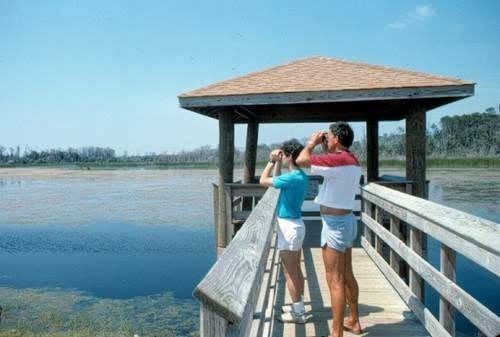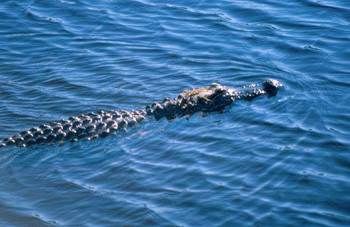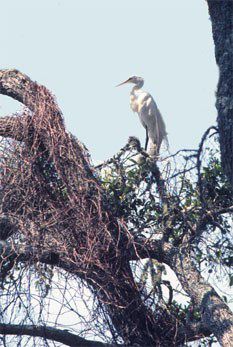 HOME: www.hiltonpond.org |
|||
- GENERAL ARTICLES -
 HOME: www.hiltonpond.org |
|||
- GENERAL ARTICLES -
(Note: The draft below was submitted to WildBird magazine; the article that actually appeared in print may have been edited.)

From the mountains to the sea, South Carolina is home to an impressive assortment of bird species. Four main physiographic provinces span the state: a Blue Ridge mountain region in the northwestern corner; rolling Piedmont terrain that makes up almost a third of the land; a narrow band of Sandhills that delineate ancient shoreline; and the flat, expansive Coastal Plain. These vastly different habitats make it easy to see breeding warblers, migrant shorebirds, and endangered woodpeckers, and moderate weather allows good birding almost every day of the year.
The most likely place in South Carolina to find the greatest variety of avifauna is at the coast, where inland, freshwater, and marine species coexist in good numbers. There are hundreds of coastal birding spots--nearly every Carolina birder has his or her "special" cove--but since some are locations under private ownership, the four state parks spread along the coast are your best bet for unrestricted birding success. From north to south, state parks are at Myrtle Beach, Huntington Beach, Edisto Beach, and Hunting Island. All have campsites and--except for Huntington Beach--family cabins; you could easily take in all four over a three-day span.
Having visited these parks with binoculars and field guide in hand, I'd say Myrtle Beach State Park is the least productive spot for heavy-duty birding. The park is on US 17-Business, a few miles south of the city of Myrtle Beach. Myrtle is one of the great "touristy beaches" of the East Coast, and the concentration of people, miniature golf courses, water slides, amusement parks, and an adjoining air force base make for a noisy day of birdwatching. Even with all this human activity, you're almost guaranteed in early summer to see breeding Blue-gray Gnatcatchers, Pine Warblers, and Brown-headed Nuthatches in mixed woods at the campground. Out on the beach, Brown Pelicans--making a comeback and no longer endangered in South Carolina now that DDT has been banned--fly and fish during all seasons. Even on blustery winter days you can see plenty of gulls, including Herring, Ring-billed, Bonaparte's, and Laughing.
The two southernmost parks--Edisto Beach and Hunting Island--have all these species plus many others and are more idyllic and natural. Both, however, are harder to get to to. Edisto is on SC 174, accessible by taking US 17 south for about 40 miles from Charleston, or from the Walterboro exit off I-95. Hunting Island, famous for its vintage lighthouse, is even further south and is accessed most easily via US 21 from I-95. If you're planning to camp at a state park in peak season, get there early in the morning and wait for someone to depart a campsite.
These first three parks are very nice places to visit, but if I had limited time and my druthers, I'd skip them and drive instead to Huntington Beach State Park, about 15 miles south of Myrtle Beach on US 17. I've been to many birding meccas around the country--Hawk Mountain, Cape May, and Madera Canyon, to name a few--but Huntington Beach is still my all-time favorite spot. The state acquired this property from the family of Anna Hyatt Huntington, a world-renowned sculptor whose outdoor works are on display at Brookgreen Gardens across the highway from the park. Many of my fellow nature-lovers agree that Huntington Beach may be the most important acquisition ever made by South Carolina's park system.
As you leave four-lanes of traffic on US 17 to enter the park, you're struck by the sudden quiet. Tall pine trees and live oaks festooned with Spanish moss soak up unnatural noises and make it easy to hear a variety of bird songs. Even from the car you can hear the "peter, peter" of Tufted Titmice, "chewink" calls from Rufous-sided Towhees, and the repetitive "tea-kettle" trill of South Carolina's state bird, the Carolina Wren. Between April 1 and Labor Day you'll need to stop at the gate shack to pay your daily entrance fee of $3 per vehicle; better yet, help support the natural history programs of the park system by buying an annual pass for just $25--especially if you plan to visit other sites mentioned in this article. (NOTE: In July 2001, there was a $4 per-person entry fee; season passes cost $40 at that time.)
From this point on, birding is sheer delight. You'll first drive about a quarter mile through the oak-pine woods, but with windows down you can add more species by sound, including Pileated Woodpecker, Yellow-billed Cuckoo, Northern Parula, and Summer Tanager. There have even been endangered Red-cockaded Woodpeckers sighted in this area. As the road curves hard to the right you enter a beautiful grove of live oaks, and just beyond is a small grassy area where you can park. Grab your spotting scope and binocs and walk about 30 yards further along the road to one of the most unusual birding opportunities on the East Coast.
Where the dark canopy gives way to blue sky, the causeway from the mainland to Huntington Beach quickly proves to be an amazing spot (top photo). On your right you'll see a body of water lined by cattails indicative of a freshwater pond, but to the left is Spartina grass characteristic of saltwater mudflats. Indeed, the dike under the road actually serves as a dam to separate the freshwater impoundment from tidal ocean water.  All along this amazing causeway are spots to view these two very different habitats and the wide variety of birds they attract.
All along this amazing causeway are spots to view these two very different habitats and the wide variety of birds they attract.
I usually start my survey with the freshwater pond, being careful not to get too close to the American alligators (above left) that sometimes sun along the bank. Typically there's the expected assortment of wading birds, including Great Blue, Little Blue, and Tricolored Herons; Great Egrets (below right) and Snowy Egrets; and both night-herons. If you're lucky in spring and summer, you can even see the secretive Least Bittern. (NOTE: In July 2001 we spotted a dozen Wood Storks, a sometimes-difficult bird to get for South Carolina.) Common Moorhens, Pied-billed Grebes, Clapper Rails, and Anhingas are here all year, and in winter there are rafts of puddle and diving ducks and mergansers that always seem to know where the alligators are. This dark-watered, glassy-smooth pond provides wonderful mirrored views of male Hooded Mergansers and Wood Ducks. Ospreys work the pond frequently, hovering overhead as prelude to a sudden dive on some hapless fish that swam too close to the surface. On the southern horizon are likely to be other soaring birds--especially Black and Turkey vultures, or even an occasional Southern Bald Eagle from the coastal breeding population. Once, as I scanned the sky for raptors not far from here, I was amazed to spot a Magnificent Frigatebird.
If traffic isn't heavy on the causeway, you may see Marsh Wrens and Painted Buntings feeding in the shrubs, or even an occasional American Goldfinch. Seaside Sparrows flit across the road, and in winter their relative the Sharp-tailed Sparrow is fairly common. Shifting your gaze across the causeway to the saltwater side, you'll see many of the same wading birds that occur on the freshwater pond, but there also will be Black Skimmers, gulls, and--depending on the time of year--any of a few dozen kinds of shorebirds. American Avocets, Whimbrels, and Willets are all easy to identify, but differentiating between Greater and Lesser Yellowlegs and Long-billed and Short-billed Dowitchers may take a bit more effort. Most shorebirds migrate through in May, August, and September, when they work the mudflats for food to maintain their energy reserves. Their drab non-breeding plumage almost always necessitates some page-flipping in the field guide.
You could spend hours at this site, but I suggest you return to your vehicle and drive out the causeway to a fork in the road. If you go right, you'll end up at the campground and Atalaya, an interesting fortress-like impoundment where the Huntingtons once lived. A registration desk and store near the campground has light refreshments for sale and--most importantly--a free checklist of the park's birds. The latest tally is at least 255 species--not bad for any location.
Around the camping area you can see the Palmetto palm, South Carolina's state tree, or share your lunch with boisterous Boat-tailed Grackles. Live oaks and other hardwoods in this area were particularly hard hit in 1989 by Hurricane Hugo. Most trees survived the storm's 100-mile-per-hour winds, but a tidal surge covered their roots with ocean water so that salt leached into the soil. As salt-intolerant trees and shrubs die, there undoubtedly will be a change in birdlife that local observers are attempting to document.
For the best oceanside birding, backtrack to the main road and go straight at what would have been the left fork off the causeway. This road wanders for a mile through thickets of myrtle, bay, and other Lowcountry shrubs. Watch the power lines for Painted and Indigo buntings and an occasional Ground Dove.  A few hundred yards out on the left is parking for a boardwalk that leads to a gazebo in the middle of the mudflat--a great place to see everything from fiddler crabs to Soras to White and Glossy Ibises. Here I once I watched two of the dozen or so Reddish Egrets recorded for South Carolina.
A few hundred yards out on the left is parking for a boardwalk that leads to a gazebo in the middle of the mudflat--a great place to see everything from fiddler crabs to Soras to White and Glossy Ibises. Here I once I watched two of the dozen or so Reddish Egrets recorded for South Carolina.
Driving further east to the end of the road, you'll come to a bigger, paved lot complete with picnic shelters and restrooms. Park here and walk the 300-yard-long sandy trail toward the beach. There may be Purple Martins and other swallows such as Barn, Northern Rough-winged, or Bank, and--increasingly through the past decade or so--Tree Swallows. When you arrive at the ocean itself, you're greeted at low tide by a wide, gently sloping beach. If you're an early riser, you'll seldom have to share the East Coast sunrise with any other organisms except ghost crabs, dolphins, and a ton of plovers--certainly a glorious way to start the day.
Turn left and begin walking up the beach, and stay off the fragile dunes. climbing on them can cause serious erosion and destroy the Sea Oats whose roots already must battle twice daily with the destructive natural forces of high tides. You'll probably want to stop every 50 yards or so to scan the shoreline, trying to identify various peeps and plovers probing in the wet sand. Yet another endangered species, the Piping Plover, breeds above the high tide mark in small numbers, as do Least, Black, and Royal Terns.
Strolling northeast along this beach is an invigorating and relaxing activity that will probably net a few dozen bird species, but near the one mile mark you'll come to a place where you may even get a lifer or two. A large jetty extends into the ocean, and if you're dressed properly--it's cold and windy in winter--you should definitely walk out. The end of the jetty is at the limit of your binoculars' normal range from shore, and it's amazing how many marine birds are here. In January or February you can see Common and Red-throated Loons, Horned Grebes, Oldsquaws, all three scoters, and even Northern Gannets--not a bad assemblage of species visible from one spot. I'll never forget hearing my friend Russ Rogers describe how he posed awkwardly on a rock at the end of this jetty--less than six feet away from a gannet perched in the same position!
After 'scoping the waves for a while, retrace your steps to the parking lot, add up your day list, and drive to one of the great seafood restaurants at nearby Murrells Inlet. You might also want to visit Brookgreen Garden's enormous tent-like aviary for close-up views of free-flying Carolina birds.
If you're birding anywhere in South Carolina, the best source for information about species occurrences is Status and Distribution of South Carolina Birds, published in 1989 by The Charleston Museum. (Copies of this 83-page hardbound, annotated checklist are available from the Museum at 360 Meeting St., Charleston SC 29403.) The book was co-authored by Dr. Will Post, curator of birds for the Museum, and Dr. Sid Gauthreaux, professor of ornithology at Clemson University. The Post and Gauthreaux checklist contains 374 bird species that have been definitively sighted or collected in the state; another 27 are on the "provisional" list (species with less than four reported occurrences, or introduced species that are not yet established); and there are 12 "hypothetical" species whose sightings are probably legitimate but have not been documented properly by observers.
Many bird records for South Carolina are based on observations by famous names in the history of science. Mark Catesby, William Bartram, Alexander Wilson, John James Audubon and his friend John Bachman, Elliott Coues, and Arthur Trezevant Wayne all did ornithological work in the state. Their tradition lives on today in a modern generation of active birders and bird scientists, and it's possible to go to many sites that still support the same birds seen by those pioneering ornithologists. When you visit the South Carolina coast, I doubt you'll see any Whooping Cranes as Wilson did near Georgetown in 1809, but with a little work over a few days you'll surely get at least a hundred bird species to make the coastal trip worthwhile. Let us know how you do, and Happy Birding in the Palmetto State!
Up to Top of Page
Back to General Articles Main Page
Back to Bill Hilton Jr. Publications List
|
Make direct donations on-line through
Network for Good: |
|
|
LIKE TO SHOP ON-LINE?
Donate a portion of your purchase price from 500+ top on-line stores via iGive: |
|
|
Use your PayPal account
to make direct donations: |
|
 post questions for The Piedmont Naturalist |
Join the |
Search Engine for |
|
|